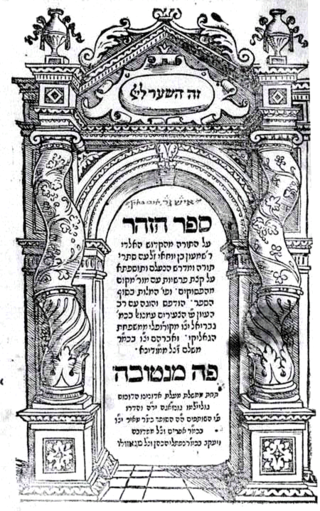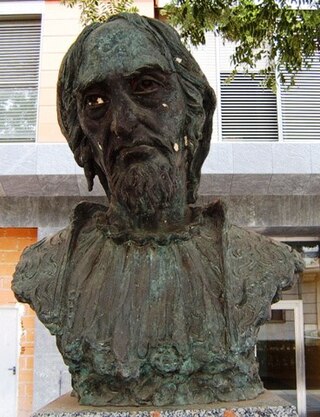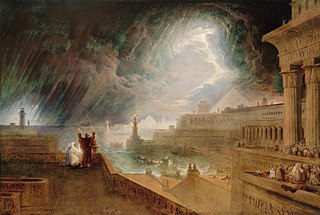Related Research Articles

The Zohar is a foundational work in the literature of Jewish mystical thought known as Kabbalah originally written in Aramaic. It is a group of books including commentary on the mystical aspects of the Torah and scriptural interpretations as well as material on mysticism, mythical cosmogony, and mystical psychology. The Zohar contains discussions of the nature of God, the origin and structure of the universe, the nature of souls, redemption, the relationship of Ego to Darkness and "true self" to "The Light of God".
Hillel ben Naphtali Zevi also known as Hillel Ben Naphtali Herz, was a Lithuanian rabbi.

Moses ben Jacob Cordovero was a central figure in the historical development of Kabbalah, leader of a mystical school in 16th-century Safed, Ottoman Syria. He is known by the acronym the Ramak.

Moses de León, known in Hebrew as Moshe ben Shem-Tov, was a Spanish rabbi and Kabbalist who first publicized the Zohar. Modern scholars believe the Zohar is his own work, despite his claim that he took traditions going back to Shimon bar Yochai and committed them to writing. His other works include Sefer ha-Rimon, written in Hebrew, and hundreds of pseudepigraphic responsa, commentaries, and Kabbalistic tracts which he falsely attributed to earlier authorities.

Va'eira, Va'era, or Vaera is the fourteenth weekly Torah portion in the annual Jewish cycle of Torah reading and the second in the Book of Exodus. It constitutes Exodus 6:2–9:35. The parashah tells of the first seven Plagues of Egypt.
Zedekiah ben Abraham Anaw was an author of halakhic works and younger brother of Benjamin ben Abraham Anaw. He lived at Rome and received his Talmudic training not only in Rome but also in Germany where he was the pupil of Jacob of Würzburg and possibly also of Abigdor Cohen of Vienna.
Yaakov ben Yaakov Moshe Lorberbaum of Lissa (1760-1832) was a rabbi and posek. He is most commonly known as the "Ba'al HaChavas Da'as" or "Ba'al HaNesivos" for his most well-known works, or as the "Lissa Rav" for the city in which he was Chief Rabbi.
Abraham ben Isaac of Narbonne (c. 1080-85 – 1158) was a Provençal rabbi, also known as Raavad II, and author of the halachic work Ha-Eshkol.
Aryeh Leib ben Moses Zuenz was a rabbi and scholar of the 18th and 19th centuries who lived in Pińczów, and later in Plotzk. He was the author of the following works:
Judah Leon ben Moses Mosconi was a Bulgarian Romaniote Jewish scholar and Talmudist born at Ohrid. Owing to the wars which agitated Bulgaria in the 14th century, Mosconi left his native country about 1360. He traveled in all the three continents of the Old World. He was in Chios and Cyprus, in Négropont, in Laodicea, and later in Egypt. He was afterward in Morocco, in Italy, and in France. In Perpignan he made the acquaintance of several scholars, among them Moses Narboni and David Bongoron.
Kalonymus ben Kalonymus ben Meir, also romanized as Qalonymos ben Qalonymos or Calonym ben Calonym, also known as Maestro Calo was a Jewish philosopher and translator from the Hachmei Provence of Provence, France. Kalonymus studied philosophy and rabbinical literature at Salon-de-Provence under the direction of Abba Mari ben Eligdor and Moses ben Solomon of Beaucaire. Kalonymus also studied medicine, but seems not to have practiced it.
Johan Kemper (1670–1716), formerly Moshe ben Aharon Ha-Kohen of Kraków or Moses Aaron, baptized Johann Christian Jacob; was a Polish Sabbatean Jew who converted from Judaism to Lutheran Christianity. His conversion was motivated by his studies in Kabbalah and his disappointment following the failure of a prophecy spread by the Polish Sabbatean prophet Zadok of Grodno, which predicted that Sabbatai Zevi would return in the year 1695/6, It is unclear whether he continued to observe Jewish practices after his conversion.
Pardes Rimonim is a primary text of Kabbalah composed in 1548 by the Jewish mystic Moses ben Jacob Cordovero in Safed, Galilee.
Milhamoth ha-Shem or Milhamoth Adonai is the title of several Hebrew polemical texts. The phrase is taken from the Book of the Wars of the Lord referenced in Numbers 21:14–15.
Aaron Moses ben Mordecai was one of the few cabalistic writers of East Prussia: author of a work, "Nishmat Shelomoh Mordecai", so called in remembrance of his son, who died in early childhood. On the title-page the statement is made that the work is a commentary on M. Ḥ. Luzzatto's "Ḥoḳer u-Meḳubbal"; indeed the text of this treatise is printed in the volume. Aaron used the name of Luzzatto merely to give greater vogue to his own book, because of the waning influence of the Cabala in Poland at the time. In reality, Aaron's work is a commentary on the "'Eẓ Ḥayyim" of Ḥayyim Vital, the arch-apostle of the cabalistic school of Luria. Aaron Moses states that he was the author also of a commentary on the Midrash Tanḥuma, entitled "Zebed Ṭob". This has not been printed.
Aaron Jekel ben Samuel Schor of Frankfurt also known as the Beis Aharon of Frankfurt was a 17th-century Jewish-German rabbi and Hebrew author, best known for his work "Beis Aharon", which is considered to be amongst the most important concordances of the Bible.
Gerrit Bos is professor emeritus of Jewish studies.
Moses ben Menahem (Präger) was a rabbi and kabbalist who lived in Prague in the seventeenth and eighteenth centuries.
Aaron Moses ben Ẓebi Hirsch Lwow was a grammarian, scribe, and dayyan of Lemberg.
References
![]() This article incorporates text from a publication now in the public domain : Sossnitz, Joseph Loeb (1901). "Aaron Selig ben Moses of Zolkiev". In Singer, Isidore; et al. (eds.). The Jewish Encyclopedia . Vol. 1. New York: Funk & Wagnalls. p. 21.
This article incorporates text from a publication now in the public domain : Sossnitz, Joseph Loeb (1901). "Aaron Selig ben Moses of Zolkiev". In Singer, Isidore; et al. (eds.). The Jewish Encyclopedia . Vol. 1. New York: Funk & Wagnalls. p. 21.